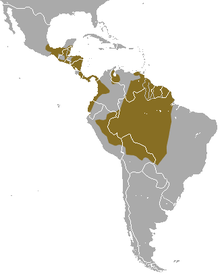Gray four-eyed opossum
| Gray four-eyed opossum[1] | |
|---|---|

| |
| Scientific classification | |
| Domain: | Eukaryota |
| Kingdom: | Animalia |
| Phylum: | Chordata |
| Class: | Mammalia |
| Infraclass: | Marsupialia |
| Order: | Didelphimorphia |
| Family: | Didelphidae |
| Genus: | Philander |
| Species: | P. opossum
|
| Binomial name | |
| Philander opossum | |
| Subspecies | |

| |
| Gray four-eyed opossum range | |
| Synonyms | |
|
Didelphis opossum Linnaeus, 1758 | |
The gray four-eyed opossum (Philander opossum) is an
Description
It has a sharply defined white spot above each eye, hence the common name.
Behavior
The species is
Gray four-eyed opossums do not have a well defined territory, and home range stability depends on the availability of adequate resources.
The gray four-eyed opossum does not "play dead" like the North American
Gray four-eyed opossums build nests out of dry leaves in hollow trees, tree forks, fallen logs and in ground burrows.[6] They roll up into a ball while sleeping and although their eyes are actually closed, the white patches of fur above their eyes gives them the appearance of an awake animal.[6]
Reproduction
Little is known about gray four-eyed opossums mating habits but they are in the family Didelphidae and so most likely to be polygynous.[5] This means males compete with other males. There are no courtship displays or pair bonds formed in didelphids.[5]
Reproduction is typically seasonal, with more young being born during the rainy season when there is an abundance of fruit.[5] During the dry season, fewer babies are born due to the lack of available fruit.[5] Litter sizes averaging between four and five young, with each female producing between two and four litters per year. Many young die while nursing in the mother's pouch.[5] This death rate is especially high during the dry season.[5] A major factor that determines survival of young is the mother's age; there are many deaths when the mother is less than 11 months.[6]
The average gestation period for the gray four-eyed opossum is 13 to 14 days, and each newborn weighs about 9 grams (0.32 oz).[5] They nurse in their mother's pouch until they are 68 to 75 days old.[5] Once weaned, they stay in their mother's nest for a further 8 to 15 days before their mother becomes aggressive and expels them.[5]
Diet
The gray four-eyed opossum has an omnivorous diet containing fruits, nectar, insects, small mammals (such as mice), birds, reptiles, amphibians, crustaceans, snails, and earthworms.[6] Its diet varies depending on the season.[6]
With such a varied diet, the gray four-eyed opossum will both encounter and eat venomous snakes. While the bites of these snakes may be harmful to most animals, the gray four-eyed opossum is able to overcome the toxic effects due to its immunity to the toxins.[7] The immunity was initially thought to come from an immune response leading to the production of antibodies, but in fact it comes from toxin-neutralizing proteins found in opossum serum.[7][8] These proteins are produced by the opossum prior to any encounter with a venomous snake, thus this immunity is not learned but inherited.[7]
References
- OCLC 62265494.
- ^ . Retrieved 11 November 2021.
- ^ ISBN 978-0-226-28240-4.
- ^ OCLC 493329394.
- ^ a b c d e f g h i j k l m Martina, L.; Waters, M. (2014). "Philander opossum (On-line)". Animal Diversity Web. Retrieved 2015-04-08.
- ^ S2CID 198968841. Archived from the originalon November 24, 2012. Retrieved April 8, 2015.
- ^ S2CID 21264310.
- PMID 33023159.

